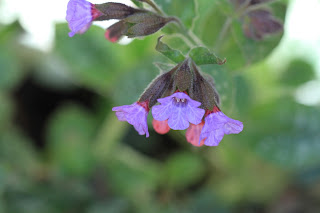Left: Kähler Vase with Lungwort; Right: Kähler Vase on Hazelnut Shells
In this POTS and PLANTS episode, we pair Kähler Keramik vase and Pulmonaria (lungwort). The sun peeked out for a few minutes on a winter day and out we went outside to play with pots. As I write, I see we already feature this vase in the Kähler and Colchicum post. That entry contains more history about Kähler pottery that we’ll include here.
I can’t even remember where the vase came from but I’ve always liked the blue color and black design, vaguely reminiscent of leaves. I believe the design was created with a process called horn painting, literally a cow horn filled with slip and used like a pen to draw on the piece. On the bottom of the vase the “HAK” mark is incised. I don’t have a date for the production of this piece, but hazard a guess that it’s after 1920 and before 1960. How’s that for precise?
The featured plant, Pulmonaria, has been in our yard for about 15 years and has suffered much abuse: a house remodel, fence re-do, much foot traffic, and poor care to boot. Finally, we finished our house projects, moved the lungwort to a location with less foot traffic, and ignored it for a few years. It seems to be coming back.
Pulmonaria is in the Boraginaceae (Borage) family. I’d guess we have P. officinalis here. From Quattrocchi, the origin of the generic name is:
Latin pulmo, pulmonis “lung,” adj. pulmonarius, a, um “diseased in the lungs, curative of the lungs.”
Most sources of information about lungwort says something like this: the characteristic spots on the leaves and perhaps the leaf shape suggest lungs, and back when the plant was named (by Linnaeus) it was commonly thought to cure ailments of the lungs. This line of thinking is courtesy of the Doctrine of Signatures, a philosophy of the use of plants that goes back at least 2,000 years. If a plant looks like a part of the body, it cures it. There are many information sources today that echo the modern version of this idea of similarity equals cure. I’m sure by chance, there are some plants that are said to cure something because they look like it, actually might or do. In Weeds: In Defense of Nature’s Most Unloved Plants by Richard Mabey writes a lot about, well weeds, and many were and are used in traditional remedies.
“The doctrine of signatures was sympathetic magic tidied up, stripped of its blatant magical influences, and given Christian authority. What it taught was that God has ‘signed’ plants, with certain suggestive shapes and colours, say, in order that humans could ‘read’ the illnesses they were designed to ease.”
If only it were so simple. Following the trail of lungwort back in time (oh because we have a couple of hours to kill on a Sunday night), things get muddled. I tried to find lungwort in Nicholas Culpeper’s Complete Herbal (first published in 1653). However, all I could find was the lichen called Lobaria pulmonaria which also – are you ready for it? - looks like lung tissue. As an example of the doctrine of signatures, here’s what Culpeper, the curious 17th century herbalist and some might say quack, says about the lichen in an 1816 edition of the book:
p. 243 Lung-wort. It helps infirmities of the lungs, as hoarsness, coughs, wheezing, shortness of breath, &c. You may boil it in Hyssop-water, or any other water that strengthens the lungs.
p. 304 Syrupus Scabiosae Or Syrup of Scabious. College.] Take the roots of Elecampane, and Polypodium of the Oak, of each two ounces, Raisins of the sun stoned an ounce, Sebestens twenty, Colt’s-foot, Lungwort, Savory, Calaminth, of each a handful and an half, Liquorice, Spanish Tobacco, of each half an ounce, the seeds of Nettle and Cotton, of each three drams, boil them all (the roots being infused in white Wine the day before) in a sufficient quantity of Wine and Water to eight ounces, strain it, and adding four ounces of the Juice of Scabious, and ten ounces of sugar, boil it to a Syrup, adding to it twenty drops of oil of sulphur. Culpeper.] It is a cleansing Syrup appropriated to the breast and lungs, when you perceive them oppressed by flegm, crudites, or stoppings, your remedy is to take now and then a spoonful of this Syrup, it is taken also with good success by such as are itchy, or scabby.
Pages from Culpeper’s Complete Herbal

It sounded like a delightful cocktail up to the drops of sulphur. Then the crudites just spoiled it completely. Even if it is the wrong lungwort it gives you an idea of the Doctrine of Signatures.
But I felt unsatisfied, because I wondered, not whether lungwort cures ailments of the lungs, but why there are spots on the leaves at all. You would think that that question would be easy to find, but sadly it isn’t. All the “other stuff” comes up first when searching. The first reference I found to the spots is in an article on Pulmonaria by Tony Avent where the reason is given as:
The silver spots on pulmonaria leaves are actually the result of foliar air pockets, used for cooling the lower surface of the leaves. These air pockets mask the appearance of chlorophyll in the leaves, creating the foliar patterns that we enjoy as gardeners. The logical conclusion is that cultivars with more silver in the leaves should be able to tolerate more heat and possibly sun.
Left: Kähler Vase with Lungwort; Right: Lungwort Flowers


Left: Lungwort Flowers (Pulmonaria officinalis); Right: Incised HAK Mark on Bottom of Vase




nice
ReplyDelete